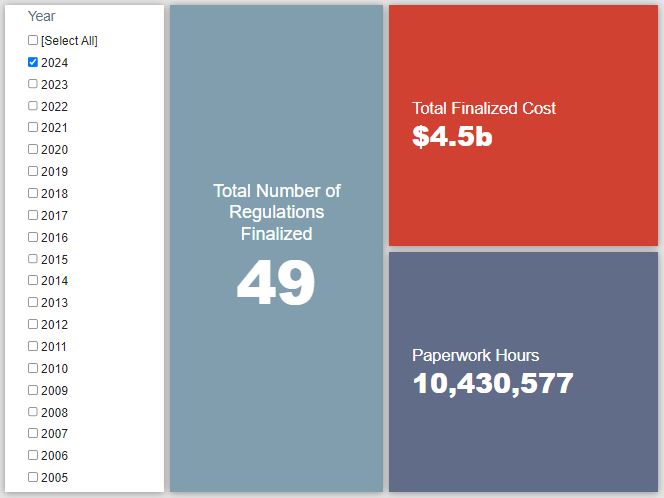Week in Regulation
March 4, 2024
A Modest End to February, Despite the Leap Day
While the last week of February had an additional day due to 2024 being a leap year, the regulatory output was fairly understated. There were nine rulemakings in the pages of the Federal Register that had some measurable economic impact. None, however, exceeded even the $100 million cost threshold. The relative stand-out of the bunch was a Department of Health and Human Services (HHS) measure addressing aspects of the Child Care and Development Fund (CCDF). Across all rulemakings, agencies published $112.5 million in total costs and added 437,936 annual paperwork burden hours.
REGULATORY TOPLINES
- Proposed Rules: 47
- Final Rules: 49
- 2024 Total Pages: 15,406
- 2024 Final Rule Costs: $4.5 billion
- 2024 Proposed Rule Costs: $31.4 billion
NOTABLE REGULATORY ACTIONS
The most consequential rulemaking of the week, from a cost perspective, was the HHS rule regarding “Improving Child Care Access, Affordability, and Stability in the Child Care and Development Fund.” As HHS puts it, CCDF “is the primary federal funding source devoted to supporting families with low incomes afford child care and to increasing the quality of child care for all children.” This rule seeks to “(1) lower families’ costs for child care, to increase access to child care and improve family well-being; (2) strengthen CCDF payment practices to child care providers, to expand parents’ child care options and better support child care operations; and (3) reduce program bureaucracy for families, to make it easier for families to enroll in CCDF.” These updates will involve some administrative costs for the state-level agencies charged with dispersing such funding to beneficiaries. HHS expects the costs of the rule’s “required policies” to amount to nearly $41 million over a five-year period, with an additional $20 million for the agencies that elect to implement the rule’s “optional policies.”
TRACKING THE ADMINISTRATIONS
As we have already seen from executive orders and memos, the Biden Administration will surely provide plenty of contrasts with the Trump Administration on the regulatory front. And while there is a general expectation that the current administration will seek to broadly restore Obama-esque regulatory actions, there will also be areas where it charts its own course. Since the AAF RegRodeo data extend back to 2005, it is possible to provide weekly updates on how the top-level trends of President Biden’s regulatory record track with those of his two most recent predecessors. The following table provides the cumulative totals of final rules containing some quantified economic impact from each administration through this point in their respective terms.![]() The Biden Administration saw modest upward shifts in its final rule cost and paperwork totals with respective increases of $107 million and approximately 423,000 hours. The HHS rule discussed above provided the bulk of the former while a Securities and Exchange Commission rule provided most of the latter. There was virtually no movement in the Trump-era totals. In contrast, the Obama Administration saw some sizeable increases – especially on the paperwork side with a 3.4-million-hour spike. An HHS rule implementing the Affordable Care Act’s “Summary of Benefits and Coverage and Uniform Glossary” requirements was the driver of this trend.
The Biden Administration saw modest upward shifts in its final rule cost and paperwork totals with respective increases of $107 million and approximately 423,000 hours. The HHS rule discussed above provided the bulk of the former while a Securities and Exchange Commission rule provided most of the latter. There was virtually no movement in the Trump-era totals. In contrast, the Obama Administration saw some sizeable increases – especially on the paperwork side with a 3.4-million-hour spike. An HHS rule implementing the Affordable Care Act’s “Summary of Benefits and Coverage and Uniform Glossary” requirements was the driver of this trend.
THIS WEEK’S REGULATORY PICTURE
This week, the Federal Motor Carrier Safety Administration (FMCSA) is updating its regulatory standards – by way of the Infrastructure Investment and Jobs Act – for vehicles transporting passengers to “recreational activities.” Source: Photo by Federico Artusi on Unsplash
Source: Photo by Federico Artusi on Unsplash
Last Monday, FMCSA published a final rule entitled “Exemption From Operating Authority Regulations for Providers of Recreational Activities.” Typically, companies that provide interstate transport of passengers or “federally-regulated commodities” need to duly register such operations with FMCSA. As the title suggests, the agency is adjusting its regulatory code to clarify that certain vehicles used to transport people to and from certain recreational activities. The statutory impetus for this change is, interestingly enough, a provision from the recent Bipartisan Infrastructure Law.
The new exemption language has both quantitative and qualitative criteria. In terms of measurable aspects, the “motor carriers” in question need to be operating vehicles that carry “between 9 and 15 passengers (including the driver)” and travel “within a 150 air-mile radius of the location at which passengers initially boarded.” As for the types of activities the exemption applies towards FMCSA say they “include but are not limited to hiking, biking, horseback riding, canoeing, whitewater rafting, water trails, tubing, skiing, snowshoeing, snowmobiling, hunting, fishing, mountain climbing, swimming, and off-highway vehicle driving and riding.”
While such a definition is relatively expansive, there are some exclusions. FMCSA makes sure to spell out that operators that do not intrinsically tie the transportation aspect to the provision of these “recreational activities” are not eligible for the exemption. As the agency explains: “For example, a bus company offering scheduled route service with multiple stops would not fall within the exemption merely because one of the scheduled stops was at or near a water park or a horseback riding stable.”
The primary rationale for this exemption clarification, according to FMCSA, is that “it will benefit carriers by improving the efficiency of their business operations and increase both consumer and producer surplus.” In the rule’s analysis, the agency notes various uncertainties, such as acknowledging that operators may still be liable to state-level registration requirements, but broadly believes that the rule will provide modest relief in administrative burdens for affected operators. Additionally, having a more clearly defined idea of their exemption status could provide ancillary benefits in the form of greater flexibility when purchasing the appropriate level of insurance coverage for the vehicles in question.
The rule’s updated exemption criteria go into effect April 26, 2024.
TOTAL BURDENS
Since January 1, the federal government has published $35.9 billion in total net costs (with $4.5 billion in new costs from finalized rules) and 28.4 million hours of net annual paperwork burden increases (with 10.4 million hours coming from final rules).










